

Clothing in the Viking Age. Questions about Viking Age clothing are possibly the most common ones I receive.
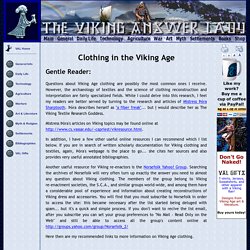
However, the archaeology of textiles and the science of clothing reconstruction and interpretation are fairly specialized fields. While I could delve into this research, I feel my readers are better served by turning to the research and articles of Mistress Þóra Sharptooth. Þóra describes herself as "a fiber freak"... but I would describe her as The Viking Textile Research Goddess.
Mistress Þóra's articles on Viking topics may be found online In addition, I have a few other useful online resources I can recommend which I list below. Another useful resource for Viking re-enactors is the Norsefolk Yahoo! Here then are my recommended links to more information on Viking Age clothing. General Topics.
Courtship, Love and Marriage in Viking Scandinavia. Part I -- Forward and Introduction Forward Some time ago, some friends of mine came to me and asked me to tell them how a Viking wedding was conducted.
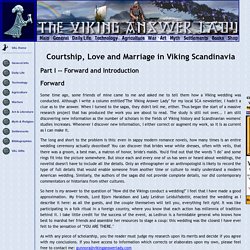
Although I write a column entitled"The Viking Answer Lady" for my local SCA newsletter, I hadn't a clue as to the answer. When I turned to the sagas, they didn't tell me, either. Thus began the start of a massive research project that has produced the work you are about to read. The long and short to the problem is this: even in sappy modern romance novels, how many times is an entire wedding ceremony actually described? "Thor's Hammer" Found in Viking Graves. Kate Ravilious in York, U.K.

Long dismissed as accidental additions to Viking graves, prehistoric "thunderstones"—fist-size stone tools resembling the Norse god Thor's hammerhead—were actually purposely placed as good-luck talismans, archaeologists say. The Vikings - Britons, Gaels, Picts, Angles and Vikings. The Vikings were Norsemen who came to raid and pillage, to trade and to settle in Scotland.
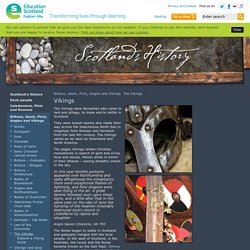
They were expert sailors who made their way across the treacherous North Sea in longships from Norway and Denmark from the late 8th century. The Vikings sailed as far west as Greenland and North America. The pagan Vikings raided Christian monasteries in search of gold and silver, food and slaves. Monks wrote in horror of their attacks – seeing dreadful omens in the sky.
In this year terrible portents appeared over Northumbria and sadly affrightened the inhabitants: there were exceptional flashes of lightning, and fiery dragons were seen flying in the air. Anglo-Saxon Chronicle, AD 793. Beyond Lands' End: Viking Voyage 1000. Click on the images below to view enlargements Nomads of the North Atlantic: The Original Viking Ships Without their marvelous sailing ships, the Vikings would have played a much smaller part in history.
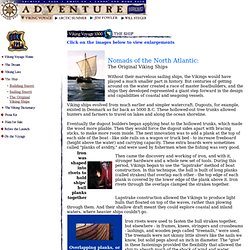
But centuries of getting around on the water created a race of master boatbuilders, and the ships they developed represented a giant step forward in the design and capabilities of coastal and seagoing vessels. Viking ships evolved from much earlier and simpler watercraft. Dugouts, for example, existed in Denmark as far back as 5000 B.C. These hollowed-out tree trunks allowed hunters and farmers to travel on lakes and along the ocean shoreline. Viking Age. The Viking Age is the period from 793 to 1066 in European history, especially Northern European and Scandinavian history, following the Germanic Iron Age.
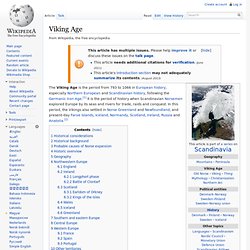
It is the period of history when Scandinavian Norsemen explored Europe by its seas and rivers for trade, raids and conquest. In this period, the Vikings also settled in Norse Greenland and Newfoundland, and present-day Faroe Islands, Iceland, Normandy, Scotland, Ireland, Russia and Anatolia.[2] Historical considerations[edit] Norse Social Structure. The ancient Vikings Social structure was relatively simple, and followed many of the common traits all societies exhibit.
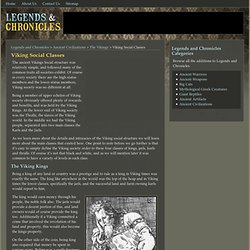
Of course in every society there are the high status members and the lower status members, Viking society was no different at all. Social Classes in Viking Society. Social Classes in Viking Society Three social classes existed in Norse society.
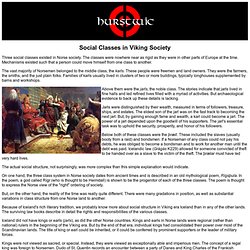
The classes were nowhere near as rigid as they were in other parts of Europe at the time. Mechanisms existed such that a person could move himself from one class to another. Viking Ships. The Vikings were almost better at handling the rudder than the plough.

They where skillful shipbuilders and excellent navigators. The time called the Viking age begun ca 800 AD when the people in Scandinavia started to travel overseas to trade, but also to rob and conquer. Because of their superiority as seamen and soldiers the Vikings conquered land after land. Only after a couple of hundred years the European people learned how to fight the Vikings successfully, and the Viking age ended in the middle of the 11th century. The reason why the Scandinavians were so superior at sea was that they invented the keel. It is not known how high the ships was, but probably not very high.
The Vikings had different vessels for different purposes. LEVS : Viking FAQs : Transportation. The Vikings : Ships, seafarers & life at sea : Sea & ships fact files. 'Viking' was the name given to the people from Norway, Denmark, Finland and Sweden.
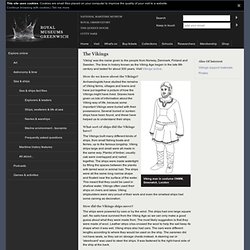
The time in history known as the Viking Age began in the late 8th century and lasted for about 300 years. Visit Vikings online. How do we know about the Vikings? Viking man in costume ©NMM, Greenwich, LondonArchaeologists have studied the remains of Viking farms, villages and towns and have put together a picture of how the Vikings might have lived. Graves have given us lots of information about the Viking way of life, because some important Vikings were buried with their possessions.
"Thor's Hammer" Found in Viking Graves. The truth about Vikings: Not the smelly barbarians of legend but silk-clad, blinged-up culture vultures. It’s the cry that struck fear into our ancestors’ hearts for 300 years... “the Vikings are coming!”. They were huge, bearded barbarians in animal fur tunics and horned helmets who raped and pillaged their way across four continents and “went berserk” on battlefields.
Or were they? That’s certainly the stereotypical image of the Norse warriors handed down through ancient sagas, history books and, more recently, films and TV series. But it looks like the Vikings had a bit of a bad press – well, three centuries of it – thanks to the understandably-miffed monks whose monasteries they looted. Now, a stunning new exhibition at the British Museum is redrawing the cartoon caricature of these Scandinavian savages to reveal them in a fascinating new light. They were a contradictory bunch – shameless raiders yet shrewd traders; pagans yet culture vultures; smelly soap-dodgers who hated messy hair; and testosterone-fuelled warriors who believed girl-power won their battles.
The Vikings. The ancestors of the Vikings traded with the Romans. They exported furs, skins, walrus ivory and amber. After the fall of Rome the Scandinavian peoples slowly grew more united. The first towns were formed. Meanwhile they started using sails. Before the mid-7th century Scandinavian ships were rowed but once they began using sails they could make the long voyage across the North Sea - with devastating results for the people who lived further south. Vikings. Vikings in Scotland and the Western Isles. Dear Viking Answer Lady: My family's tradition has always maintained that our family once were Vikings who ruled the Orkney Isles. However, all of the ancestors we have been able to locate are settled firmly in Scotland.
Viking chieftain's burial ship excavated in Scotland after 1,000 years. A Viking ship, which for 1,000 years has held the body of a chieftain, with his shield on his chest and his sword and spear by his side, has been excavated on a remote Scottish peninsula – the first undisturbed Viking ship burial found on the British mainland. The timbers of the ship found on the Ardnamurchan peninsula – the mainland's most westerly point – rotted into the soil centuries ago, like most of the bones of the man whose coffin it became.
However the outline of the classic Viking boat, with its pointed prow and stern, remained. Its form is pressed into the soil and its lines traced by hundreds of rivets, some still attached to scraps of wood. An expert on Viking boats, Colleen Batey from the University of Glasgow, dates it to the 10th century. At just 5m long and 1.5m wide, it would have been a perilously small vessel for crossing the stormy seas between Scandinavia, Scotland and Ireland. He also had a knife, an axe, and a bronze object thought to be part of a drinking horn. Vikings could be to blame for why Scots have highest levels of multiple sclerosis. Study found one in every 170 women in the Orkney Islands suffers from multiple sclerosisIt is the highest rate in the world and has been linked with their Norse ancestryScientists say Vitamin D deficiency could also be to blame.
Kaftans.